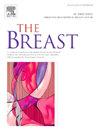A composite 18F-FDG PET/CT and HER2 tissue-based biomarker to predict response to neoadjuvant pertuzumab and trastuzumab in HER2-positive breast cancer (TBCRC026)
IF 7.9
2区 医学
Q1 OBSTETRICS & GYNECOLOGY
引用次数: 0
Abstract
Background
Early metabolic change on PET/CT was predictive of response to neoadjuvant trastuzumab/pertuzumab (HP) in TBCRC026. We hypothesized that a composite biomarker incorporating PET/CT and HER2 tissue-based biomarkers could improve biomarker performance.
Methods
83 patients with estrogen receptor-negative/HER2-positive breast cancer received neoadjuvant HP alone [pathologic complete response (pCR) 22 %]. PET/CT was performed at baseline and 15 days post initiation of therapy (C1D15). Promising imaging biomarkers included ≥40 % SULmax decline between baseline and C1D15, and C1D15 SULmax ≤3. Baseline tissue-based biomarkers included HER2-enriched intrinsic subtype (72 %, 46/64; NanoString), tumor HER2 protein abundance (median log2 13.5, range log2 7.1–15.9; NanoString DSP), and HER2 3+ (83 %, 64/77; immunohistochemistry). Logistic regressions were fitted to predict pCR with HER2/PET-CT biomarkers. The C statistic assessed overall prediction power. The optimal composite score cut-off was determined by maximizing Youden's index.
Results
Factors most predictive for pCR in single predictor models included C1D15 SULmax (OR 0.43; p = 0.007, c = 0.77), % reduction in SULmax (OR 1.03, p = 0.006, c = 0.72) and tumor HER2 protein abundance (OR 1.75; p = 0.01, c = 0.76). The composite of C1D15 SULmax and % reduction in SULmax and their interaction term, had improved probability (c = 0.89 from c = 0.78), with high sensitivity (100 %) and negative predictive value (100 %). The addition of tumor HER2 protein did not further improve prediction power (c = 0.90).
Conclusion
The HER2/PET-CT biomarker had high prediction power for pCR, however was not superior to the prediction power of PET/CT alone. Non-invasive PET/CT biomarkers may facilitate a response-guided approach to neoadjuvant therapy, allowing intensification and de-intensification of treatment, pending further evaluation.
一种复合18F-FDG PET/CT和基于HER2组织的生物标志物预测HER2阳性乳腺癌患者对新辅助帕妥珠单抗和曲妥珠单抗的反应(TBCRC026)
背景:PET/CT上的代谢变化可预测TBCRC026患者对新辅助曲妥珠单抗/帕妥珠单抗(HP)的反应。我们假设结合PET/CT和基于HER2组织的生物标志物的复合生物标志物可以提高生物标志物的性能。方法83例雌激素受体阴性/ her2阳性乳腺癌患者单独接受新辅助HP治疗[病理完全缓解(pCR) 22%]。在基线和治疗开始后15天(C1D15)进行PET/CT检查。有希望的成像生物标志物包括基线与C1D15之间SULmax下降≥40%,C1D15 SULmax≤3。基于组织的基线生物标志物包括her2富集的内在亚型(72%,46/64;NanoString),肿瘤HER2蛋白丰度(log2中位数13.5,log2范围7.1-15.9;NanoString DSP)和HER2 3+ (83%, 64/77;免疫组织化学)。采用Logistic回归预测HER2/PET-CT生物标志物的pCR。C统计量评估总体预测能力。通过最大化约登指数确定最佳综合分界点。结果在单一预测模型中,最能预测pCR的因子包括C1D15 SULmax (OR 0.43;p = 0.007, c = 0.77), SULmax减少% (OR 1.03, p = 0.006, c = 0.72)和肿瘤HER2蛋白丰度(OR 1.75;P = 0.01, c = 0.76)。C1D15 SULmax和SULmax减少百分比及其相互作用项的组合概率从c = 0.78提高到c = 0.89,具有高灵敏度(100%)和阴性预测值(100%)。肿瘤HER2蛋白的加入并没有进一步提高预测能力(c = 0.90)。结论HER2/PET-CT生物标志物对pCR有较高的预测能力,但并不优于单独PET/CT的预测能力。非侵入性PET/CT生物标志物可能促进反应导向的新辅助治疗方法,允许强化和去强化治疗,有待进一步评估。
本文章由计算机程序翻译,如有差异,请以英文原文为准。
求助全文
约1分钟内获得全文
求助全文
来源期刊

Breast
医学-妇产科学
CiteScore
8.70
自引率
2.60%
发文量
165
审稿时长
59 days
期刊介绍:
The Breast is an international, multidisciplinary journal for researchers and clinicians, which focuses on translational and clinical research for the advancement of breast cancer prevention, diagnosis and treatment of all stages.
 求助内容:
求助内容: 应助结果提醒方式:
应助结果提醒方式:


